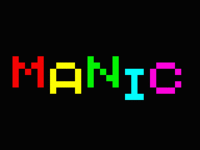It takes a little knack to figure out the ranging. Each level adds more ships. I think it might be possible to add an animated shot flying from your cannon to the target, rather than simply have a numeric countdown and then "splash." Maybe some speed ups could be done too, to make it a little more challenging.
The second project I completed since Miner was a program called "Geography." This one I got from a German VZ200/Laser Fan Club software repository on the Net: http://www.wolkenkratzerhaus.de/VZ/Historie.htm. It has been a really valuable resource in the past and I thought I would take another look. There are so many programs listed and all the descriptions are German, so it is hard to guess what's there. Some program descriptions mentioned "Englisch" so I took a look and found "Geography". The remarks in the program seem to indicate that it might have originally been from a Coco book and then migrated to VZ by way of a PET stage.
2100 REM GEOGRAPHY, CC BOOK 2
2110 REM FIT TO PET BY ANDY GAMBLE NOV 79
2120 REM FIT TO VZ 200 BY STEFAN ROEBBEL JUN 86
2130 REM COLUMBIA COLLEGE
2140 REM 1619W 10 AVE VANCOUVER BC
Added my name to the list. 2018 seems like quite a jump! But the program had already travelled from the Rocky Mountains to Germany in space, so a little leap by time is perhaps not that unusual.
It has quite a list of names stored in its DATA statements. I added a little graphic partial world map that I found in a Sinclair Spectrum program listing. Not sure if I translated the Speccy semigraphic characters completely correctly, but from the description of the graphics I found on the net, it seemed the best I could do. Here is the original listing:
AAAAAEEDDNPPLAAAIAAJAACIAAAAAAAA
AAAAGEADABPPKAABAAAJAAPEMAEAAAAA
MMEJPMIMKBPLCAAEMIAONPPPPPMPOMMA
PPPMPPCEDFLAMAANHONPPPPPPPPPPPPC
LHPOPOAPOACAAEBHBPPPPPPPPPPLDFAA
ABPPPPOPPIAAAGOONPPPPPPPPPPOABAA
AAPPPPJPDBAAAMLLPDHHHPPPPPPLIAAA
AAPPPPPCAAAAADABBDPNPPPPPPHAKAAA
AAFPPLLAAAAAANPOMMPHPPPPPPIBAAAA
AAAHPAEAAAAAEPPPPPHOJHPPPLCAAAAA
Each letter represents a semigraphic character from the following list
From various experiments it seemed like the order of the top 2 lines went like this
ABCDEFGH
PONMLKJI
But the resulting picture seems a little odd/fuzzier than it should. I tried some add hoc substitutions but it didn't seem to make much improvement so I left it pretty much as is.
Well that is the end of my RetroChallenge activities for this month. All the best to the other contestants. I've enjoyed popping into a few projects that looked interesting (mostly ones with programming aspects looking for ideas) and reading John's mid contest update. Thanks again to John for organizing and to all the other contestants for their efforts. Keep on retrocomputing!
Addendum
Thanks to Solar Penguin (Pippa) I learned that the Speccy and the ZX81 don't use the same block character set. Since my map data was from the Speccy, my map didn't look right. Now it does.






